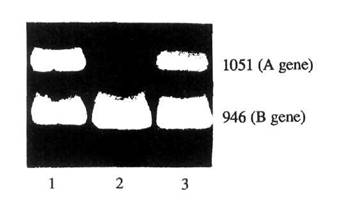
|
Pisum Genetics |
Volume 25 |
1993 |
Research Reports |
pages 32-33 |
The early nodulin gene Enod12A is in linkage group 3
|
Men1, A.E., Borisov1*, A.Y., |
1Research Institute for Agricultural Microbiology, |
|
Rozov2, S.M., Tsyganov1, V.E. |
Podbelsky Chosse 3, St. Petersburg-Pushkin 8, |
|
and Tikhonovich1, I.A. |
189620, Russia |
|
2Institute of Cytology and Genetics, Novosibirsk, |
|
|
630090, Russia |
Enod12 was identified as a nodulin gene which is involved in an infection process during the pea-rhizobium interaction (3). There are two copies of the Enod12 gene in the pea genome with known primary structure, i.e Enod12A and Enod12B (1). We have shown previously by the PCR method that there was a polymorphism in the promotor region of Enod12A (2). In order to follow segregation of the Enod12A gene by PCR, a pair of primers was chosen such that the PCR with DNA of line NGB1238 resulted in misamplification of Enod12A whereas both genes were amplified in case of the laboratory line Sprint-2 (Fig. 1). The sequences of the PCR primers used are as follows:
5' -AAGTGGTCACACATGATAAGA-3' - 5' -end of the promoter region
5' -GCTTTAGATATGGATGTTATGTTC - 3' -end of the coding region

Fig. 1. Electrophoresis of the PCR products of genes Enod12A (upper band) and Enod12B (lower band) in 1.5% agarose gel. Molecular weights are indicated on the right side. 1. Parent line Sprint-2. 2. Parent line NGB1238. 3. F1 hybrid NGB1238 x Sprint-2.
*Correspondence to: A.Y. Borisov; Fax 7 812 470 4362, Email chief@riam.spb.su
Table 1. Segregation data for genes B and Enod12A obtained from the F2 of cross NGB1238 x Sprint-2.
|
Number of plants with phenotype |
Chi-squared | Recomb. fract. ± SE | |||||
| B Enod12A | B enod12A | b Enod12A | b enod12A |
B |
Enod12A |
Joint |
|
| 34 | 4 | 4 | 8 | 0.03 | 0.03 | 15.76* | 17.9±6.1% |
* P = 0.00007
The results of segregation in F2 after crossing NGB1238 and Sprint-2 showed linkage between Enod12A and the linkage group 3 marker b (Table 1). Our results also indicate the location of gene Enod12B as preliminary data of A.V. Kozik (pers. comm.) show an absence of recombination between Enod12A and Enod12B.
A combination of the classic genetic and molecular-biological methods may also be useful for studying other pea genes affecting different stages of the symbiotic process.
Acknowledgements. This work was financially supported by the Research Program INTERBIOAZOT and partially funded by the National Programs Frontiers in Genetics and Fundamental Biological Research.
1.
Govers, F., Harmsen, H., Heidstra, R.,
Michielsen, P., Prins, M.,
Van Kammen, A. and
Bisseling, T. 1991. Mol. Gen. Genet. 228:160-166.
2.
Kozik, A.V., Matvienko, M.A., Men, A.E., Zalensky, A.O. and Tikhonovich,
I.A.
1992. Molekulyarnaya Biologiya
26(3):591-595 (in Russian).
3.
Scheres, B., Van De Wiel, C., Zalensky, A., Horvath, B., Spaink, H.,
Van Eck, H., Zwartkruis,
F., Wolters, A.-M., Gloudemans, T., Van Kammen, A.
and Bisseling, T.
1990. Cell 60:281-294.